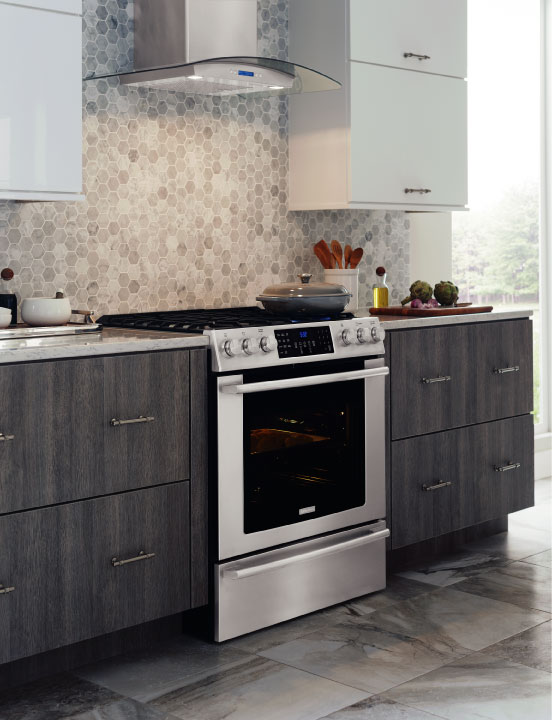Range hoods are an essential form of ventilation for any residential kitchen. Whether you choose a range hood or opt for a downdraft ventilation system, your kitchen is complete without this vital equipment. So, here we will explore range hoods to help you determine the benefits of investing in a good one.
The Advantages of a Range Hood
There are a number of reasons why it is beneficial to include a range hood in your kitchen design.
- A Shield For Your Cabinetry: During cooking smoke, odors, humidity, and heat along with ultrafine food particles can contribute to the discoloration and damage to your cabinetry. If an accident occurs and you have a fire on your cooktop, a good range hood providing proper ventilation will act as a metal barrier to prevent the fire from spreading to your cabinetry.
- Provides Additional Light: Even if you’ve planned the lighting in your kitchen entirely, your cooktop can still benefit from the additional light. Many models of range hood provide extra lighting to illuminate your cooking area.
- Cools Your Kitchen: If you’re cooking several dishes, it is very easy for your kitchen to start feeling swelteringly hot. A well-vented range hood can expel the excess heat out of your kitchen, so you can concentrate on preparing a great dish without getting hot under the collar.
- Cleans Your Air: When vented properly, a range hood can collect any dirty, smelly cooking greases from your air and expel it outdoors. This should prevent a greasy film from accumulating on your kitchen surfaces.
- Completes Your Kitchen Aesthetic: An attractive and impressive range hood can also provide a massive visual impact for your kitchen design. It is not only a functional appliance, but you can also use it as a statement piece to tie together all your design elements. For example, if you have chosen stainless steel appliances, a polished stainless steel range hood can allow these features to be showcased.
Choosing a Range Hood
The choice of range hood largely depends on your budget, personal tastes and the manufacturer requirements for your cooktop or range. Generally, the greater investment in a range hood you make, the better quality and more functionality While there are cheaper hoods, better models have built-in ventilation to help regulate temperature and clean the air. This an essential feature for any keen cooks.
Most range hood models are rated by CFM or cubic feet per minute. This defines the amount of air that will be circulated per minute. The higher the rating, the greater the ventilation provided. Just be wary of models that have a rating of more than 400 CFM as you will need an additional “make up air unit.”
How Should I Use My Range Hood?
Once you’ve chosen and installed a range hood, you need to know the best way to use it for optimum results. Many people assume that they should just switch a range hood on if it starts to get steamy inside the kitchen, but this approach does not provide the best results. A better idea is to switch on the range hood fan at least a few minutes before you begin cooking. You should run the fan while you’re cooking and leave it running for 10 to 15 minutes after you’ve finished. This will remove any unwanted heat or humidity. As the heat inside your kitchen and around the stovetop increases, you should turn up the fan power. It is best to err on the side of caution and use a higher fan speed than you think. This removes the risk of filling up your kitchen with heat and grease that can result from too low a fan speed.
If you’re considering a range hood, you can explore your options with this range hood collection or speak to a home appliance expert for a more specialized service.

